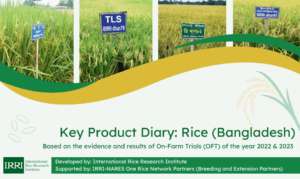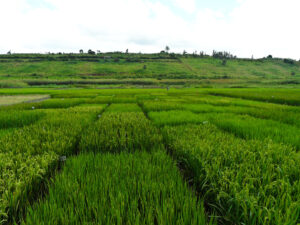Ensuring food security amidst the increasing population requires a pest surveillance system for staple food. Regularly collected pest surveillance data serve as the basis for the development of timely pest management recommendations and provisions of targeted interventions to reduce yield losses and mitigate pest risks.
Specific and targeted pest surveillance systems in most countries are designed to prevent the introduction and movement of pests and pathogens for trade and quarantine purposes and reduce the threat of plant pests on food security.
Ensuring food security also requires general or passive surveillance in most countries to detect plant pests, characterize pest constraints and assess the intensity of injuries caused by endemic and nonregulated pests and not just those that are regulated.
A country where pest surveillance is being conducted for regulated and non-regulated pests to ensure food security is the Philippines.
It is estimated that 12.8 million tons of rice are needed to meet the demand of its population which is projected to reach 118 million by 2025. Aside from the growing population, the rice supply gap persists which is partly attributed to unfavorable geography, insufficient irrigation water, the occurrence of adverse weather, inefficiency in rice production technology, and decreasing rice production areas due to conversion of land for non-agricultural use.
These constraints are aggravated by yield losses from acute and chronic pests, specifically, insect pests, diseases, weeds, and rats, which indicates that increasing rice production in the country requires the development of ecologically based pest management strategies and the ability to prevent or mitigate pest risks.
Reduction of yield losses caused by pests and provision of targeted interventions rely heavily on the capacity of the Philippine Department of Agriculture (DA) to acquire and provide timely information on pest risks to farmers and various stakeholders. Lack of accurate information has led to inefficient pest management strategies and waste of resources.
Pest surveillance programs have been implemented in the Philippines, the most prominent of which was the Surveillance and Early Warning System launched in 1974 as a response to massive pest outbreaks. The system was based on systematic and continuous monitoring of pests in farmers’ fields using a standard procedure and the results were used as the basis for the timing of pest control measures. After this project was completed, access to data on pest intensity, production situation, and yield was difficult, and when available, the collection procedure was not standardized.
Surveys were conducted by the International Rice Research Institute (IRRI) and the Philippine Rice Research Institute (PhilRice) in lowland rice areas in different provinces in 1987, 1996, and from 2009 to 2010 using a standard procedure. However, the data need to be updated using standard procedure because of changes in cropping practices. More specifically, new varieties have been grown, irrigation infrastructure has changed, and crop establishment in several areas has shifted from transplanting to direct-seeding to cope with the increasing scarcity of farm labor.
In 2013, the DA and IRRI launched the Philippine Rice Information System (PRISM) to provide reliable information on rice to policy-makers. The project involved pest surveillance in selected farmers’ fields in all rice-growing regions to provide the DA with updated and actionable information to improve rice production and ensure food security in the Philippines.
After the research and development phase of PRISM ended, pest surveillance was continued under the Pest Risk Identification and Management (PRIME) project which was launched in 2017. Pest surveillance in farmers’ fields is being conducted to regularly assess the incidence of pest injuries and insect count and yield; identify pest risk indicators (e.g., egg mass, insect pest population, and cropping practices) and pest risk factors; and analyzes the relationship between pests and pest injuries, production situation and yield. Results are provided to the DA and regional partners to continue providing the DA with updated information on pest constraints.
Ensuring food security amidst the increasing population requires a pest surveillance system for the staple food as currently implemented for rice in the Philippines. The implementation of monthly pest surveillance in 15 rice-growing areas of the Philippines can be attributed to the full support of the DA, close coordination between government and non-government agricultural research institutes and regional partners, and the commitment of regional partners to provide resources and manage data collection in farmers’ fields.
The system has leveraged advances in information and communication technologies in the development of a dedicated infrastructure and software applications to ensure the efficiency of data collection and management, and dissemination of pest bulletins with actionable recommendations for the DA and other stakeholders.
Results of conducted surveys as of 2020 showed the increase in the incidence and reemergence of several bacterial and fungal diseases compared to the 1990s and the emergence of dirty panicle, red stripe, and rice grain bug. The shift in pest profile is mainly associated with changes in cropping practices.
This illustrates the importance of surveillance of all pests and not only those that are regulated. Regularly collected pest surveillance data serve as the basis for the development of timely pest management recommendations and provision by the DA of targeted interventions to reduce yield losses and mitigate pest risks.
A rapid assessment of pest injuries in farmers’ fields that are not covered during monthly pest surveillance is being developed and will be integrated into the system in 2021.
The protocol was designed to assess pest intensity and coordinate timely responses during confirmed and potential pest risks in wider geographic areas. The Philippine Bureau of Plant Industry (BPI), the government agency responsible for pest surveillance, forecasting, and early warning, has manifested its commitment to sustain the pest surveillance system over the long term. BPI is using the system as a model for the surveillance of pests in other major agricultural crops that contribute to food security in the Philippines.
Read the study:
Castilla NP, Duque UG, Marquez LV, Martin EC, Callejo AML, Montecillo JD and Laborte AG (2021) Pest surveillance system for food security: A case study in the Philippines. In: Souvenir – International Web Conference on Ensuring Food Safety, Security and Sustainability through Crop Protection, August 5 & 6 2020, Bihar Agricultural University, Sabour, Bhagalpur, India. Eds. Ganguly P, Siddiqui MW, Goswami TN, Ansar M, Sharma SK, Anwer MA, Prakash N, Vishwakarma R and Ghatak A. Pp 43 – 49, ISBN: 978-81-950908-4-6.






